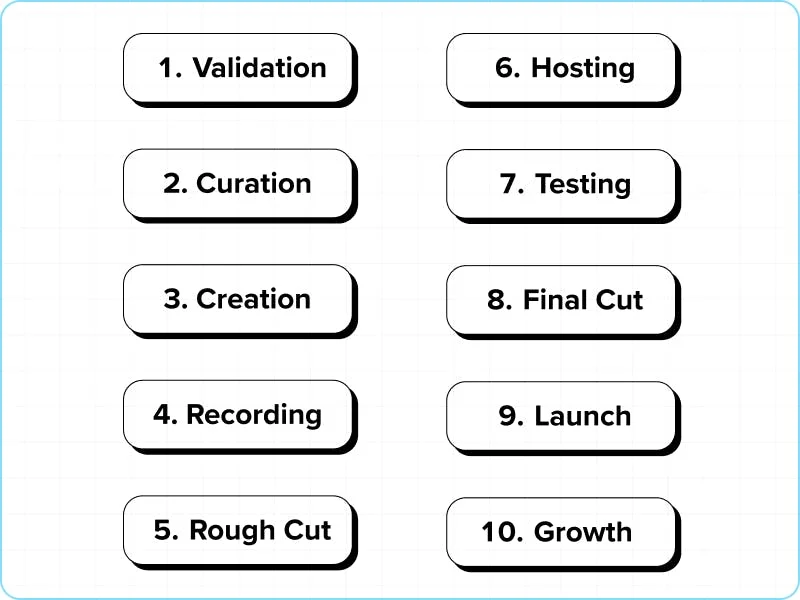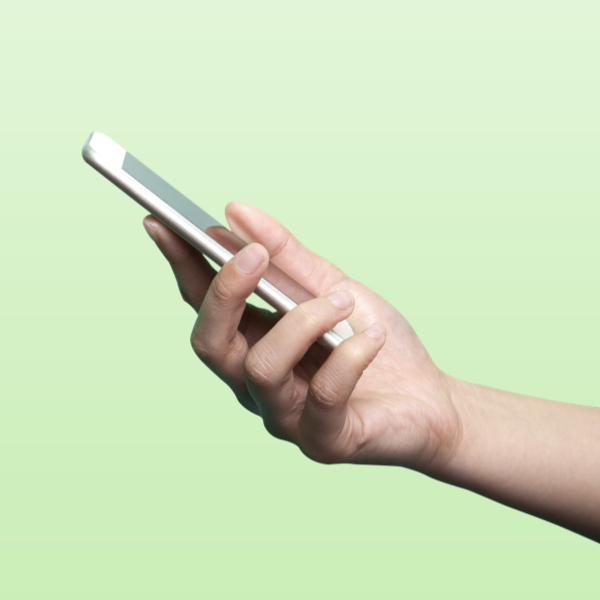Today, instead of our usual creative techniques, I’m taking you behind the scenes of my new course.
I’ll share my:
👷♂️ Process and mistakes
🧰 Tools and frameworks
💰 Expenses and revenue
Let’s dive in.
Leaving my job
Until February, I had the perfect part-time job at a VC firm. I worked with awesome people, made good money, and still had plenty of free time to create content.
The problem? I was deep in my comfort zone.
Paul Graham says there are two forms of procrastination: Per-day procrastination and per-project procrastination.
“Per-project procrastination is far more dangerous,” Paul explains.
“You keep postponing that ambitious project year after year, waiting for the perfect moment… and you’re too busy to even notice.”
The project I had been putting off was my longtime dream—creating an online course.
1. Validation
I called the course Writing with Robots: Using AI as a creative partner.
But The Lean Startup taught me that nothing’s more unproductive than productively building a product no one needs. So I had to validate my idea:
• Poll
This LinkedIn poll showed that people didn’t want another AI course. It was time for plan B.
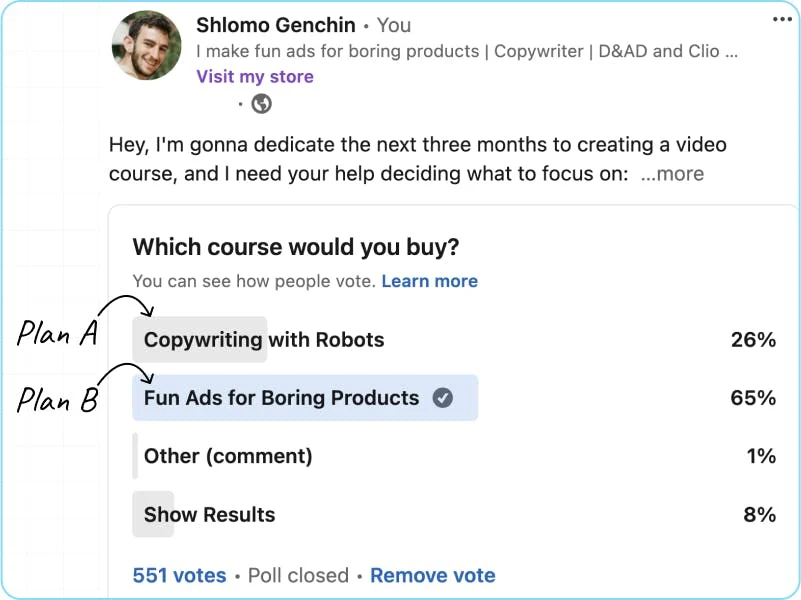
• Post
So I shared a beta version of Boring Products, Fun Ads. It performed well and opened new doors for me. The most important one was a talk at a B2B marketing conference in Tel Aviv.
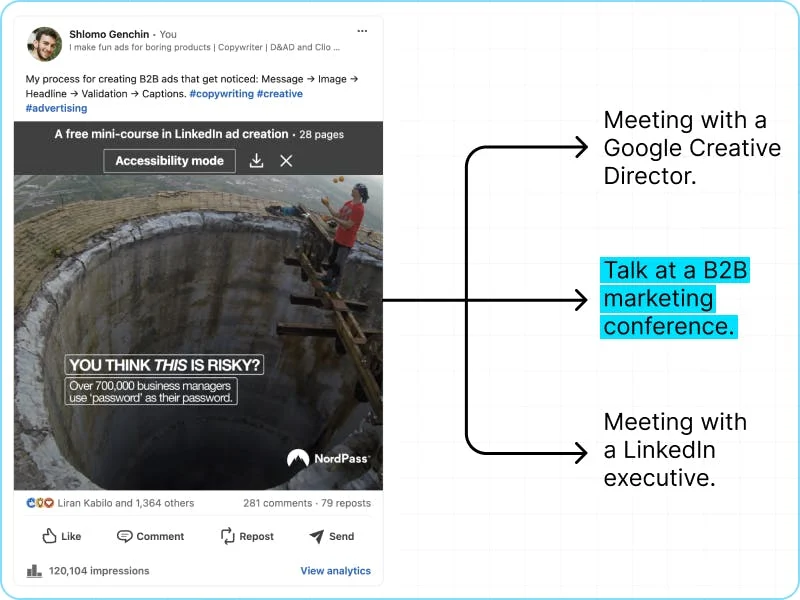
• Talk
At the end of the talk, 30 out of 150 people signed up for the waitlist. And more importantly, another speaker, a CMO, offered me a collab:
He’ll let me record the course at his company’s studio for free, and in exchange, I’ll give his team free access to the course.
That was the final reassurance I needed—people actually wanted the course!
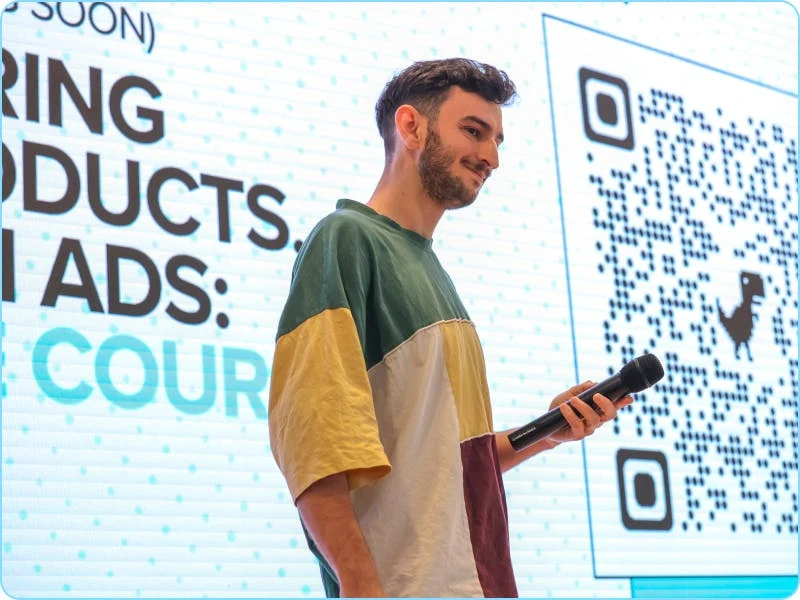
2. Curation
1 month | Feb – March, 2024
I collected and reverse-engineered thousands of ads, looking for the recipe behind them.
🛠️ Recommended ad collections:
Luerzers Archive, Adforum, and Best Ads On TV.
I also re-read my notes from Miami Ad School and many of my favorite marketing books.
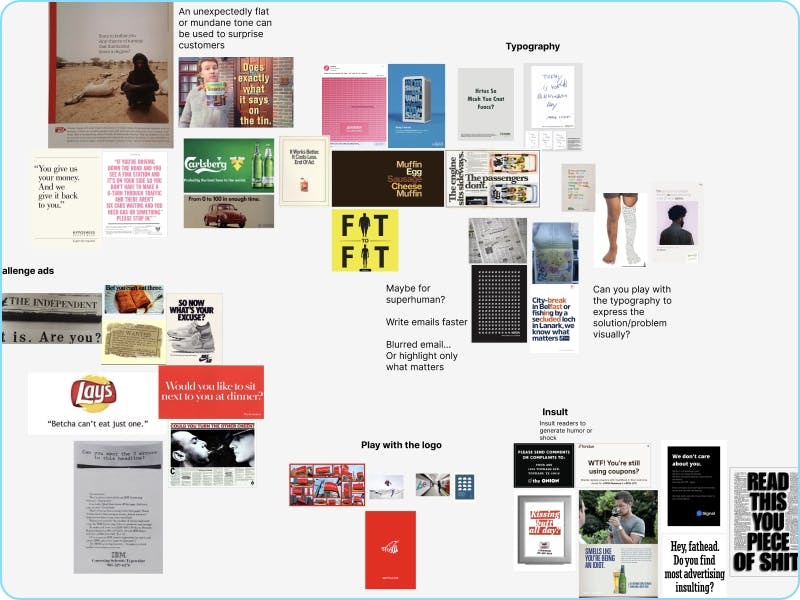
3. Creation
3 months | March – June, 2024
• Ads
I spent a month trying my new recipes on some of my favorite B2B brands.
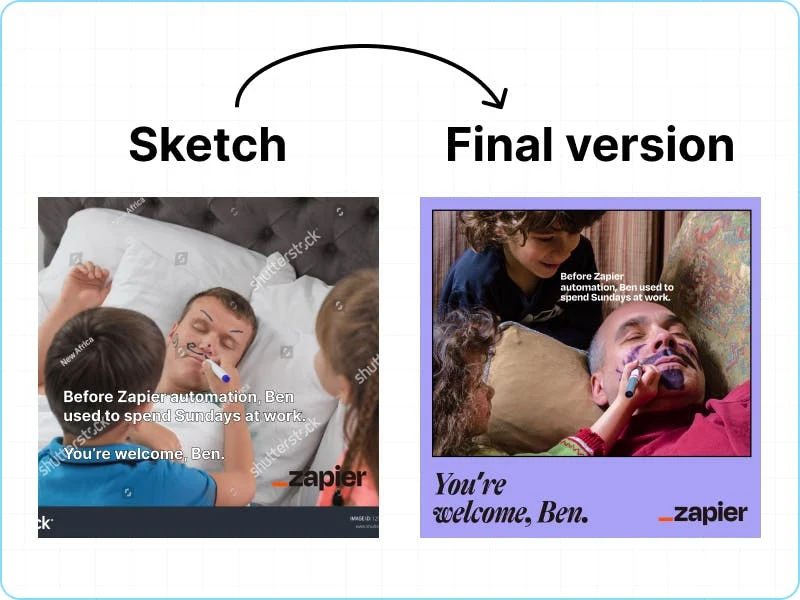
sketches into beautiful executions.
• Skeleton and learning outcomes
I organized my new ads, their recipes, and other techniques I wanted to teach into 11 chapters.
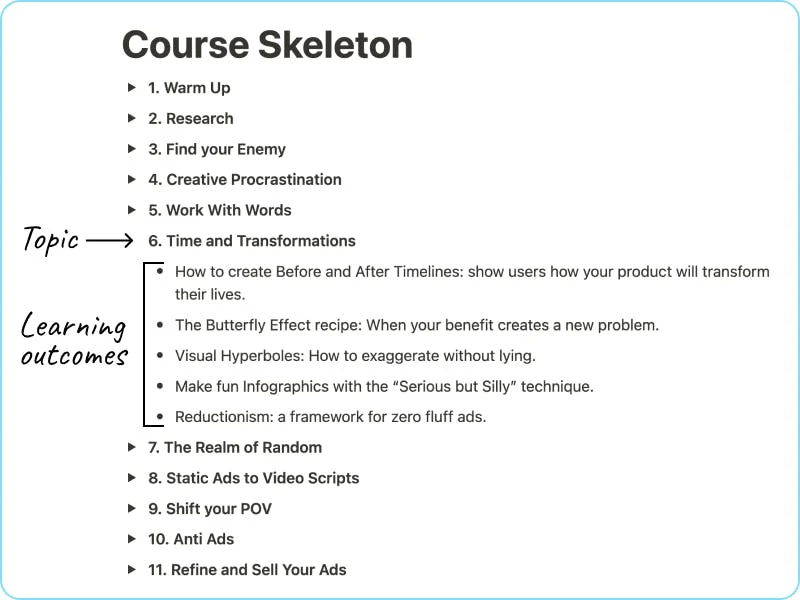
• Presentation
I designed the slides in Figma and hired a proofreader to review them.
• Anecdotes
Tahl Raz, the ghostwriter behind ‘Never Split the Difference,’ agrees to ghostwrite a book only if the client has:
- Practical frameworks
- Fascinating anecdotes
So I added personal stories to each chapter to make the material more memorable.
4. Recording
1 month | June – July, 2024
This was the most difficult part by far. Watching hours of myself on camera made me face all my insecurities: my accent, my nose, my hand movements.
Every day I returned home drained, wanting to quit.
Here’s an email I wrote to my friend Dan Nelken on a particularly tough night:
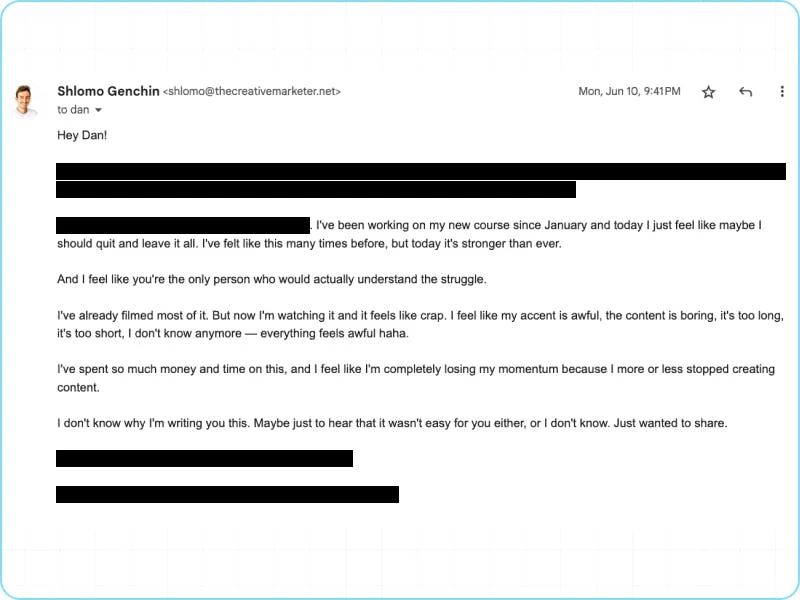
One thing that did help was my strict routine:
- 7:30 AM: Meditate, shower, breakfast.
- 8:30 AM: Bike to the studio, singing out loud to warm up my voice. (People thought I was insane.)
- 9:00 AM – 2:00 PM: Shoot one chapter.
- 2:00 PM – 3:30 PM: Head home, lunch break.
- 3:30 PM – 8:30 PM: Review footage, edit, and prep for the next day’s shoot.
- 8:30 PM – 9:30 PM: Workout.
- 9:30 PM – 11:30 PM: Dinner, overthinking, and freaking out.
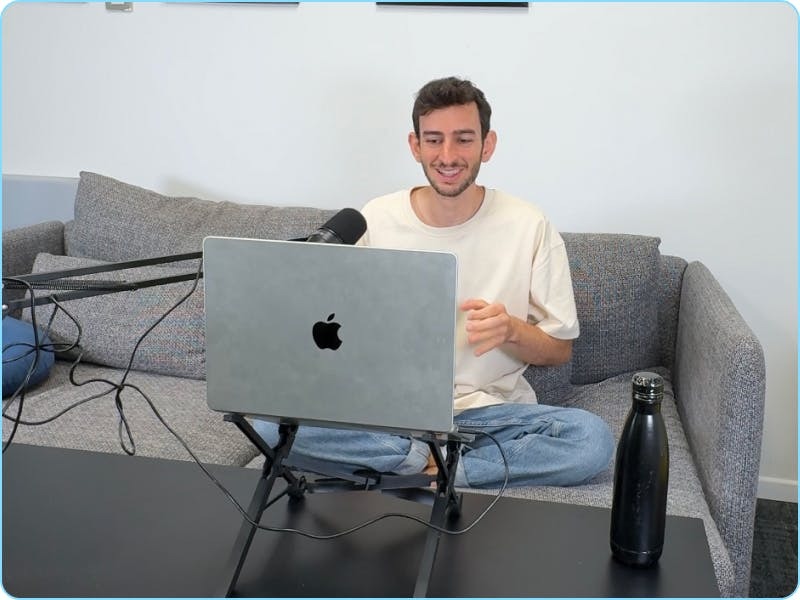
🧰 Gear and software:
- Cam: iPhone 15 Pro — Sick quality, and it connects wirelessly to my Mac.
- Mic: Shure MV7 — A course’s audio quality is even more important than its video quality. Shure’s mics are top quality.
- Screen recording: Tella.tv — I also tried Loom and Descript. Loom was too basic, and Descript was laggy.
5. Editing (Rough cut)
1.5 months | July – August, 2024
When I finished recording, I had about 30 hours of raw footage. I cut out 90% of it in Tella.
Their transcript video editor feature (edit the text instead of the video) was a lifesaver.
Then I used CapCut to finish the rest—it’s free, easy to use, and comes with simple transitions and animations.
🎧 Pro tip: audio post-production
I hired Roma, a sound designer, to fine-tune the audio.
6. Hosting
• Course host: EzyCourse
Their video player and overall student experience are better than on Kajabi and Teachable. But the backend operation—dealing with affiliates, coupons, etc.—sucks.
• Payment Processor: Paddle
It’s like Stripe, but they also handle international taxes.
• Bonus Handbook: Notion + EmbedNoptionPages
I embedded the handbook into my course platform to put it behind a paywall and improve the learning experience.
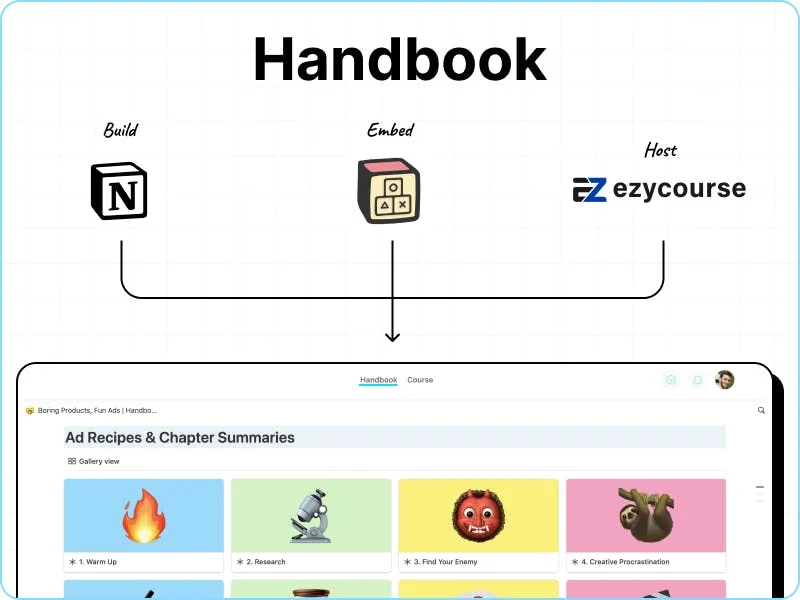
7. Testing
3 weeks | August – September, 2024
• Workshops
While developing the presentation, I ran two workshops with a tech company to test the course material.
Nothing compares to seeing people’s reactions in real life.
• Beta-testers
I asked 12 beta testers for feedback. I sent them these guidelines, asking them to focus on the following feedback:
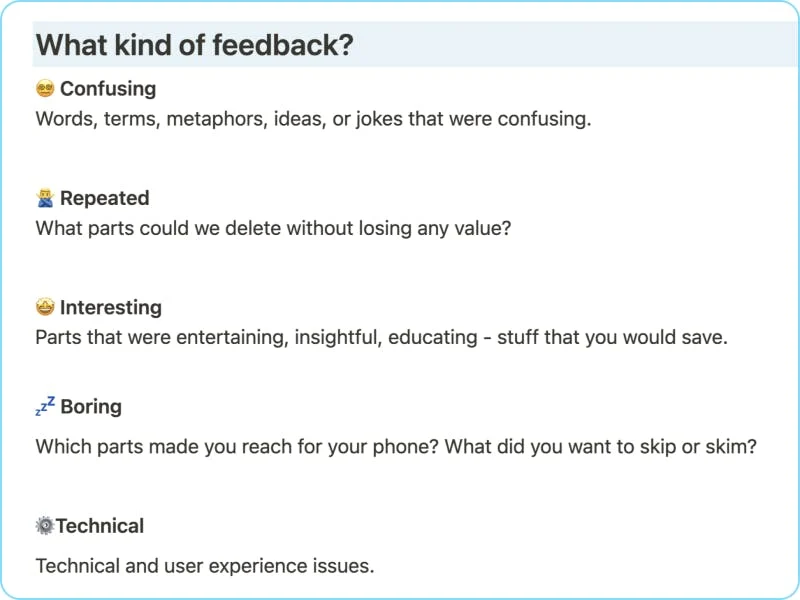
👎 What Didn’t Work:
- Flaky beta testers: 20% canceled last minute. Next time, I’ll reach out to a larger group.
👍 What Worked:
- Paid testing – The best feedback came from the proofreader I hired to watch the course.
- Testimonials – I used my testers’ positive feedback as social proof.
8. Editing (Final Cut)
3 weeks | September, 2024
Once I had all the feedback in one doc, I sat down to create the final version. I:
• Added music from Epidemic Sound
• Shortened it more
• Fixed errors
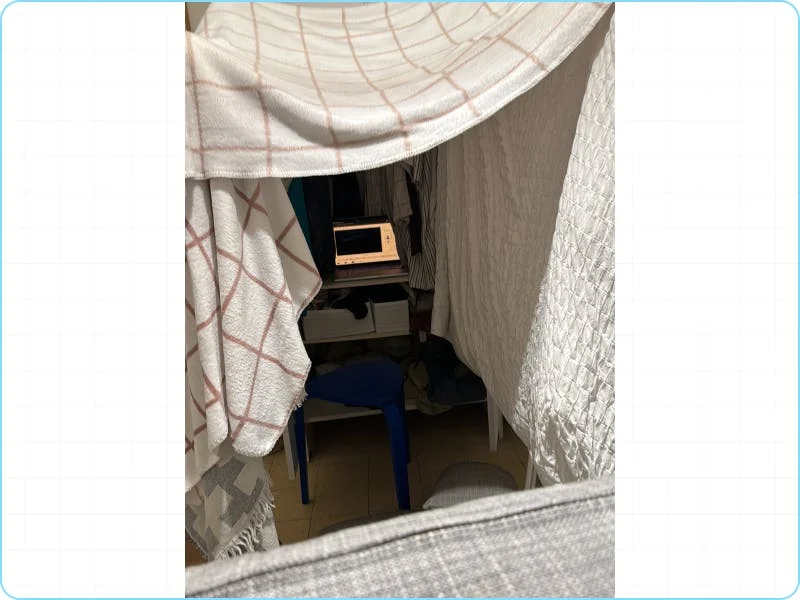
9. Launch Campaign
Landing Page
I used $100M Offers to design the offer and write the copy.
I sketched the design in Figma and sent it to my newsletter readers.
It served two purposes:
- Feedback: Amazing people like Ora went out of their way to help.
- Demand: People read the landing page and asked to buy the course.
“If you want advice, ask for money. If you want money, ask for advice.” – Unknown
Finally, I hired this UI designer to finalize it and this WordPress developer to build it.
💬 Pro Tip:
I added Crisp Chat to my site. It’s free, and many users have used it to ask questions.
Waitlist & Email Campaign
I set up this simple waitlist in May and occasionally mentioned it in my posts. On launch day, I had 550 people on the waitlist and 10,000 newsletter subscribers.
On launch week, I sent four emails, each with a different purpose:
Email #1: Nurture
Pure value, no CTA. I just wanted to remind followers I’m alive since I hadn’t emailed them in a while.
Email #2: Launch
A short version of the landing page, leading straight to checkout.
👎 Mistake: Many of my subscribers didn’t read this one because it landed in their “Promotions” folder.
In the next emails, I avoided salesy phrases like “limited time” or “buy now” or used visuals for those instead of text. It worked.
🤖 Pro Tip
I used this AI prompt to test my emails:
“Identify words that trigger email spam filters (e.g., urgency, exaggerated claims, money-related terms) and replace them with softer, more conversational alternatives that keep the message intact.
{Your email here}”
Email #3: Sneak Peek
Plenty of value. Soft CTA.
Email #4: Last Chance
I broke down the sales email itself, taking readers behind the scenes and selling at the same time.
LinkedIn posts
Then, I turned the emails into LinkedIn posts:
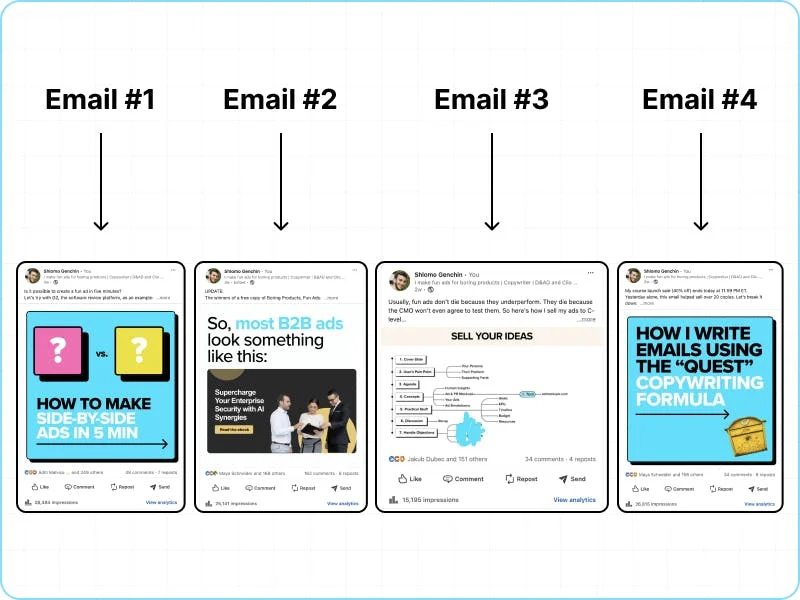
Insight: Even though I have 50k followers on LinkedIn, 90% of sales came from my 10k email list. Email is still king.
Affiliates
👍 Good: The affiliates sold about 25 copies combined.
💎 Pro Tip
I sent my affiliates this guide with copy and visual templates to save them time. I Learned this from Michal Eisik.
👎 Bad: Initially, I offered a 50% affiliate commission, but I didn’t think of the 20% VAT in most countries and the 5% transaction fee. I ended up keeping only about 25% per sale. Now, I offer a 40% commission.
10. Retention and Growth
Two weeks after the launch, a student asked for a refund. I checked and saw that he hadn’t even watched the first video.
I refunded him right away, knowing that he probably wouldn’t have returned the course if he had actually watched the first chapter.
So now, I reach out to five students every day. I encourage them to start watching and continue improving the course based on their feedback.
I plan to add monthly office hours, more templates, prompts, and challenges.
Revenue
My goal was to sell 100 copies, but I sold over 120 in the first week. Thank you SO MUCH, guys. I’m really grateful. *wipes tear*
Launch week stats:
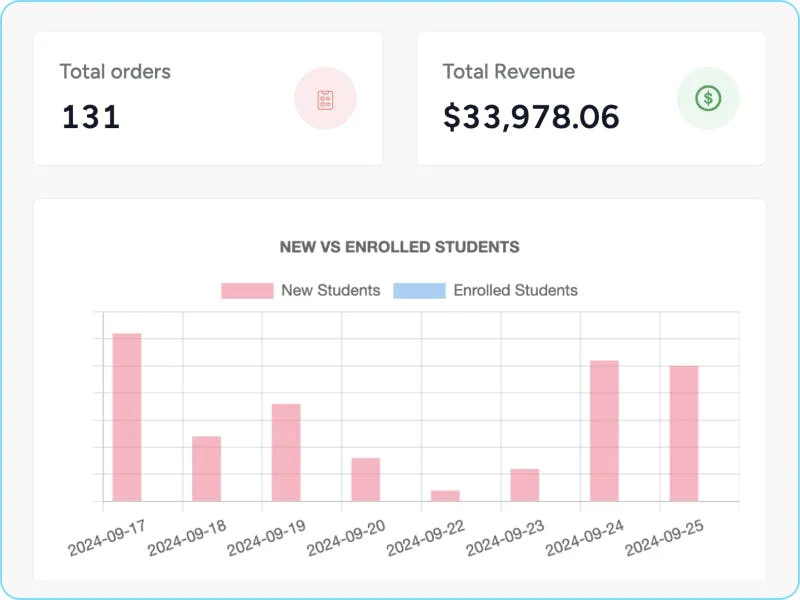
Internet money is so weird. At first, it almost felt like I was stealing and should refund everyone. But once I started getting positive feedback and speaking with students, I relaxed and let myself enjoy it.
Since the launch, private students have slowed down. Now most of the buyers are companies that want several copies and workshops.
Expenses
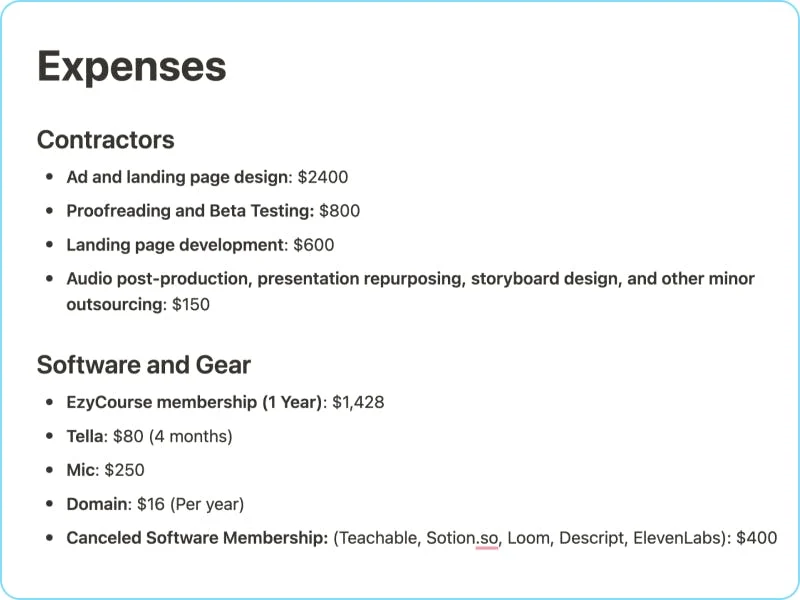
Not on the list:
- The hair transplant I’ll need after all that stress: $10K
- Not taking any client work for 7 months was the biggest investment. By the time I launched, I was totally broke haha
Summary
